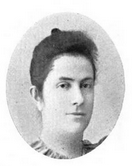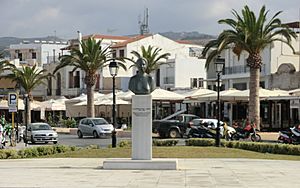Kalliroi Parren facts for kids
Quick facts for kids
Kalliroi Parren
|
|
|---|---|
 |
|
| Born | 1861 Rethymno, Crete
|
| Died | 15 January 1940 (aged 78–79) Athens, Greece
|
| Nationality | Greek |
| Occupation | Writer |
Kallirhoe Parren (Greek: Καλλιρρόη Παρρέν; 1861 – January 15, 1940) was a very important Greek writer and journalist. She is known for starting the women's rights movement in Greece during the late 1800s and early 1900s. She worked hard to improve life for women in her country.
Contents
Kallirhoe Parren's Early Life
Kallirhoe Parren was born in Rethymno, Crete, into a middle-class family. She had her first schooling at a nun's school in Piraeus. After that, she studied at the best girls' school in Athens. In 1878, she graduated from the Arsakeion School, which trained teachers.
Kallirhoe was very smart and knew many languages, including Russian, French, Italian, and English. She was invited to Odessa, where she worked for two years. There, she managed a Greek community school for girls. She also went to Adrianople for several years to run the Zapeion School for the Greek community. Finally, she settled in Athens with her husband, Jean Parren. He was a French journalist who started a French news agency in Constantinople.
Starting The Women's Journal
From Athens, Kallirhoe Parren began the women's rights movement in Greece. She did this by starting a newspaper called Ephemeris ton kyrion, which means Ladies' Journal, in 1887. This newspaper was special because it was run entirely by women.
At first, the paper came out every week and had 8 pages. This continued until 1908. Then, it became a newspaper that came out twice a month. It was published until early 1916. Kallirhoe was very good at talking to people. She convinced many famous female writers of her time to write for her paper. This was true even if those writers didn't think of themselves as feminists. The newspaper finally stopped publishing in 1917. This happened because Parren was sent away to the island of Hydra. The government, led by Eleftherios Venizelos, exiled her because she did not agree with Greece joining World War I on the side of the Entente.
Important Work for Women's Rights
While living in Athens, Kallirhoe Parren worked closely with women's movements in Europe and America. She represented her newspaper at international meetings held in Paris in 1888, 1889, 1896, and 1900. She also attended a conference in Chicago in 1893.
Even though Parren fought for women's rights, she mainly focused on getting women better education and job chances. She did not push as hard for women to get the right to vote. She did this on purpose. She wanted to build a strong base first. This way, she hoped that women voting would be more easily accepted later on. By 1908, thanks to her great efforts, the Ethniko Symvoulio ton Ellinidon (National Council of Greek Women) was created. This group was connected to the International Council of Women.
Helping Women and Children
Between 1890 and 1896, Kallirhoe founded several groups to help women. These included the Sunday School, the Asylum of Sainte Catherine, and The Soup Kitchen. In 1900, she successfully asked Minister Theodoros Deligiannis to create state protection for children and women's working conditions.
Some historians say that as Greeks worked to build their nation, women were given a role to help spread Greek culture. Parren is praised for making this role bigger for women. Through her newspaper, she asked women to be more active in showing their love for their country.
In 1896, Parren started the Union of Greek Women. This Union was very active in helping during the short Greco-Turkish War of 1897. They collected money, sewed uniforms for soldiers, and trained medical staff.
Other Achievements
Her other important achievements include:
- Founding the Lyceum Club of Greek Women in 1911. This club aimed to fight different types of unfairness in Greek society.
- Successfully pushing for women to be allowed to study at the University of Athens.
- Writing A History of Greek Women from 1650 to 1860, which was written in Greek.
Parren was also one of the people who helped start the Little Entente of Women in 1923. This group aimed to bring women together across the Balkan Peninsula. She also led the Greek part of the Women's International League for Peace and Freedom between World War I and World War II.
Kallirhoe Parren's Literary Salon
Besides all her other work, Kallirhoe Parren also ran a special gathering called a literary salon. It was known as "literary Saturdays." She was friends with many famous writers and thinkers, including Juliette Adam, Gavriilidis, Jules Simon, Xenopoulos, and the poet Kostis Palamas. Palamas even wrote a famous poem about her.
She was good friends with both women and men in her literary groups. However, if she ever felt that someone was threatening her goals for women's rights, she would fight back strongly. For example, she had a famous argument with Roldis, who was known as the father of Greek literary criticism. This argument, about women writers, was talked about in the Athenian newspapers for months in 1893.
Novels by Kallirhoe Parren
In addition to publishing her newspaper and running her salon, Kallirhoe Parren also wrote several novels. They were first printed in her Ladies' Journal under the pen name Maia. Women who read them were very excited about her stories.
Her first novels were published as a series of three books:
- I Hirafetimeni (1900; The Emancipated Woman)
- I Mayissa (1901; The Enchantress)
- To Neon Symvoleon (1902; The New Contract)
Together, these books are called Ta Vivlia tis Avyis (The Books of Dawn). They told stories about Greek women trying to achieve their goals and gain freedom. Critics like Grigorios Xenopoulos and Kostis Palamas praised the trilogy. They said it greatly helped the development of the Greek social novel. In 1907, this story became even more popular when it was made into a play called Nea Yineka (New Woman). The play starred Marika Kotopouli, who was one of the most famous actresses of the 20th century.
Parren also published two other novels: To Maramenon Krinon (The Faded Lily) and Horis Onoma (Without a Name). Sadly, the book Without a Name has been lost since it was first created.
Death
Kallirhoe Parren passed away in Athens on January 15, 1940.
See also
 In Spanish: Kalliroi Parren para niños
In Spanish: Kalliroi Parren para niños


